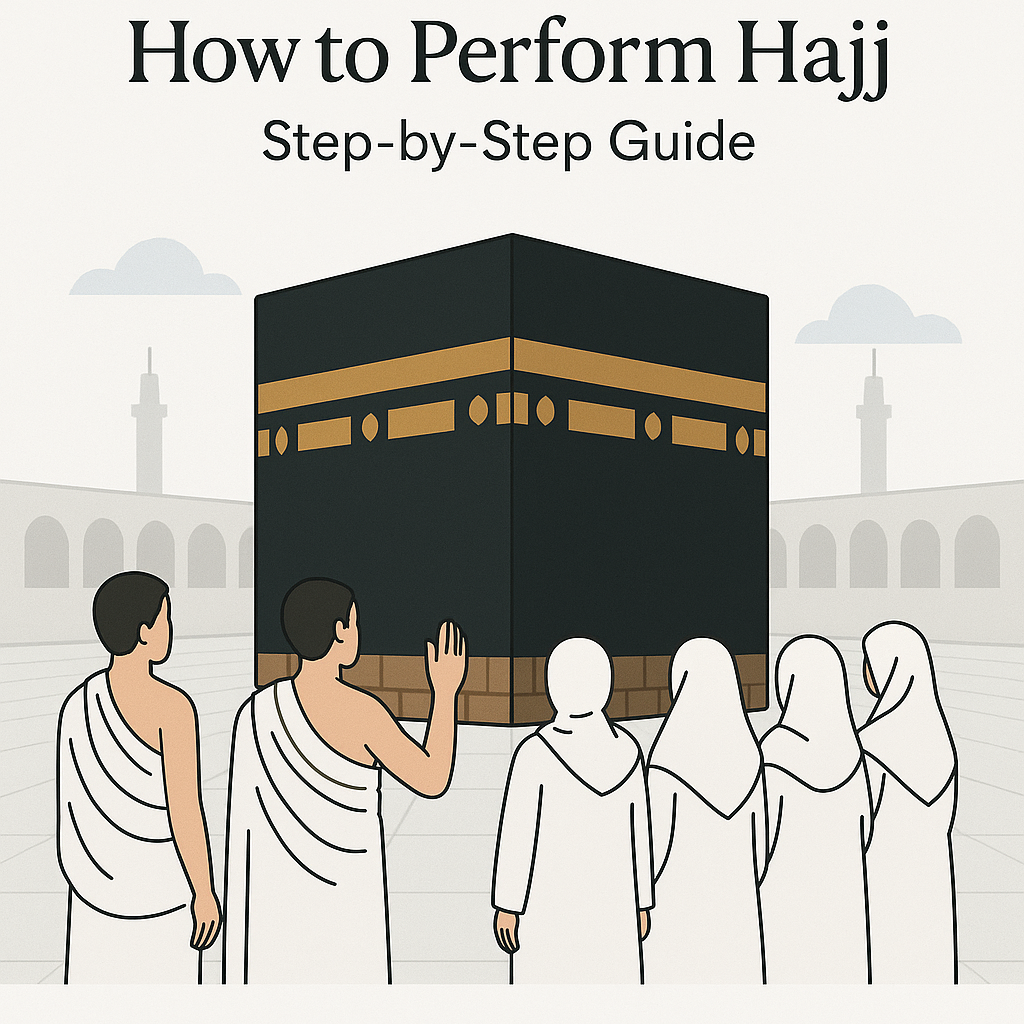What is Hajj?
Hajj is one of the five pillars of Islam and a deeply spiritual journey that every eligible Muslim must undertake at least once in their lifetime. Performed during the Islamic month of Dhul Hijjah, Hajj takes place in and around the holy city of Makkah. This guide will walk you through each step of Hajj in order, with supporting illustrations, to help you fully understand and prepare for this sacred experience. with the help this guide you will understand How to perform Hajj with clarity and confidence.
How to perfrom Hajj? Preparing for Hajj

Before embarking on Hajj, it is essential to make both physical and spiritual preparations:
- Intention (Niyyah): Begin with a sincere intention to perform Hajj solely for the sake of Allah.
- Documents: Ensure your passport, visa, vaccination certificates, and travel tickets are in order.
- Packing: Include Ihram clothing, unscented toiletries, comfortable footwear, a small bag for pebbles, water bottle, prayer mat, and necessary medications.
- Spiritual Readiness: Learn the required prayers, review the Hajj rituals, seek forgiveness, and spend time in reflection.
Step 1: Entering the State of Ihram
Upon reaching the designated Miqat (entry point), pilgrims enter the sacred state of Ihram:
- Perform a full-body purification (ghusl).
- Men wear two white unstitched cloths; women wear modest, simple clothing that fulfills Islamic guidelines.
- Make the intention for Hajj and begin reciting the Talbiyah:
“Labbayk Allahumma labbayk, labbayka laa shareeka laka labbayk…”
This state marks the beginning of your spiritual transformation and dedication to the rites of Hajj.
Step 2: Tawaf al-Qudum (Arrival Tawaf)
Upon arriving in Makkah, perform Tawaf al-Qudum:
- Enter Masjid al-Haram and proceed to the Kaaba.
- Circumambulate the Kaaba seven times in a counter-clockwise direction.
- After completing the Tawaf, pray two rak’ahs near Maqam Ibrahim if possible.
This act symbolizes the welcome and honor of entering the sacred city.
Step 3: Sa’i Between Safa and Marwah
Next, perform Sa’i:
- Walk seven times between the hills of Safa and Marwah inside Masjid al-Haram.
- Begin at Safa and end at Marwah.
- Men jog between the green markers; women maintain a normal pace.
Sa’i commemorates Hajar’s search for water for her son Ismail and reflects the perseverance and faith of a mother.
Step 4: Travel to Mina – 8th Dhul Hijjah
On the 8th of Dhul Hijjah, pilgrims head to Mina:
- Stay in tents provided for pilgrims.
- Perform the five daily prayers in congregation.
- Use this day to rest, pray, and prepare spiritually for Arafah.
This day is also known as the Day of Tarwiyah, where intentions are renewed and pilgrims begin their collective movement.
Step 5: Day of Arafah – 9th Dhul Hijjah
The Day of Arafah is the most critical part of Hajj:
- Travel from Mina to the plains of Arafat.
- From noon to sunset, engage in Wuquf — standing in reflection, supplication, and dhikr.
- Pray Dhuhr and Asr combined and shortened.
- Seek forgiveness, recite Quran, and make heartfelt dua.
The Prophet Muhammad (ﷺ) said, “Hajj is Arafah.” It is the day Allah forgives and grants mercy abundantly.
Step 6: Muzdalifah – Night of 9th Dhul Hijjah
After sunset on Arafah, pilgrims move to Muzdalifah:
- Perform combined Maghrib and Isha prayers.
- Rest under the open sky and collect 49 or 70 pebbles for the next ritual.
- Wake early for Fajr prayer.
Muzdalifah is a place of humility and gratitude, reminding pilgrims of the equality of all believers.
Step 7: Rami al-Jamarat (Stoning the Pillar) – 10th Dhul Hijjah
On the day of Eid al-Adha:
- Travel back to Mina.
- Stone the largest pillar (Jamrat al-Aqaba) with 7 pebbles, saying “Allahu Akbar” with each throw.
- Sacrifice an animal (Qurbani), reflecting the obedience of Prophet Ibrahim (AS).
- Men shave their heads; women trim a small portion of hair.
This day combines symbolic acts of submission, purification, and sacrifice.
Step 8: Tawaf al-Ifadah
Return to Makkah for Tawaf al-Ifadah:
- Perform another seven rounds of circumambulation around the Kaaba.
- Offer two rak’ahs of prayer afterward.
- Complete Sa’i if it was not done earlier.
This is a central pillar of Hajj and can be performed any time between the 10th and 12th of Dhul Hijjah.
Step 9: Days of Tashreeq – 11th to 13th Dhul Hijjah
During these days:
- Stay in Mina and continue the stoning ritual.
- Each day, throw seven pebbles at each of the three Jamarat: the small, middle, and large pillars.
- Continue to engage in worship, remembrance of Allah, and reflection.
Pilgrims may leave Mina after the second or third day, depending on their Hajj group.
Step 10: Tawaf al-Wada (Farewell Tawaf)
Before leaving Makkah, pilgrims perform the final farewell Tawaf:
- Complete seven circuits around the Kaaba.
- This Tawaf marks your departure from the holy city and your completion of Hajj.
It is a deeply emotional moment, filled with gratitude and the hope that your Hajj has been accepted.
Hajj Summary Checklist
| Date | Ritual |
| 8 Dhul Hijjah | Travel to Mina |
| 9 Dhul Hijjah | Arafah + Night in Muzdalifah |
| 10 Dhul Hijjah | Stoning, Sacrifice, Haircut, Tawaf al-Ifadah |
| 11–13 Dhul Hijjah | Stoning at Three Jamarat |
| Final Day | Tawaf al-Wada |
Frequently Asked Questions (FAQ) About Hajj
What happens on the 2nd day of Hajj (9th Dhul Hijjah)?
On the 2nd day of Hajj, pilgrims travel from Mina to the plains of Arafat. This day is known as the Day of Arafah, the most significant day of Hajj. Pilgrims stand in worship, make dua, and seek forgiveness from noon until sunset. After Maghrib, they travel to Muzdalifah, where they spend the night under the open sky and collect pebbles for the next day’s ritual.
What happens on the 3rd day of Hajj (10th Dhul Hijjah)?
On the 3rd day, also known as Eid al-Adha, pilgrims perform several key rituals:
- Stoning of Jamrat al-Aqaba (throwing 7 pebbles at the largest pillar in Mina).
- Animal sacrifice (Qurbani) to honor the devotion of Prophet Ibrahim (AS).
- Hair cutting or shaving (men shave, women trim a small portion).
- Tawaf al-Ifadah in Makkah, which is a mandatory rite of Hajj.
What happens on the 4th day of Hajj (11th Dhul Hijjah)?
Pilgrims remain in Mina and perform the ritual stoning at all three Jamarat (small, medium, and large pillars), throwing 7 pebbles at each. This day is part of the Days of Tashreeq, during which pilgrims continue worship and reflection.
When should pilgrims leave Mina?
Pilgrims may leave Mina after the third round of stoning:
- Some leave on the 12th of Dhul Hijjah after performing the stoning ritual at all three Jamarat.
- Others stay until the 13th, completing a final round of stoning before departing.
- Leaving after the 12th is permissible, but staying through the 13th is more virtuous.
How long does Tawaf take?
Completing one Tawaf (7 circuits) around the Kaaba typically takes 30 to 60 minutes, depending on the crowd. During peak Hajj days, it may take longer due to heavy congestion.
What is Takbeer in Dhul Hijjah?
Takbeer refers to the repeated declaration of Allah’s greatness, especially during the first ten days of Dhul Hijjah and the Days of Tashreeq (11th to 13th):
“Allahu Akbar, Allahu Akbar, La ilaha illallahu Wallahu Akbar, Allahu Akbar wa lillahil hamd.”
Muslims recite this after prayers and during rituals to express devotion and gratitude.
Conclusion
Hajj is more than a pilgrimage. it’s a profound renewal of faith, a purification of the soul, and a test of obedience and patience. This guide has outlined each step to help How to perform hajj with confidence and clarity. May Allah accept your Hajj and grant you a safe return with your sins forgiven.










